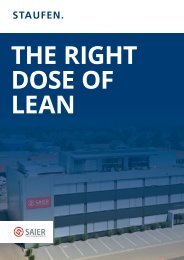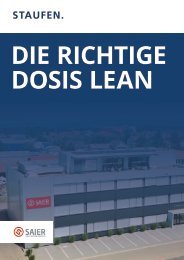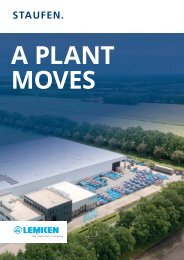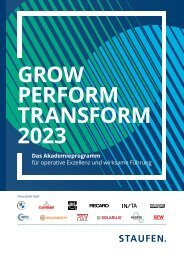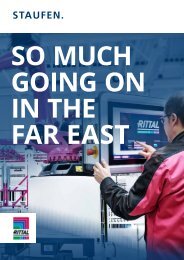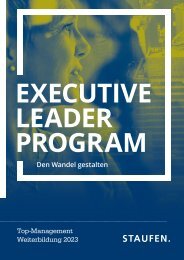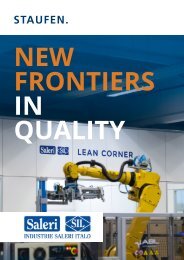Study Success in Change - Hungary
Hungarian Change Readiness Index 2019 - A study by Staufen AG
Hungarian Change Readiness Index 2019 - A study by Staufen AG
Create successful ePaper yourself
Turn your PDF publications into a flip-book with our unique Google optimized e-Paper software.
SUCCESS<br />
IN<br />
CHANGE<br />
HUNGARIAN CHANGE READINESS INDEX 2019<br />
A study by Staufen AG
CONTENTS:<br />
ABOUT THE SURVEY.<br />
S. 4<br />
PART 1: GENERAL QUESTIONS.<br />
PART 2: CHANGE READINESS INDEX.<br />
2.1 STRUCTURE.<br />
2.2 PROCESSES.<br />
2.3 MANAGEMENT AND CORPORATE CULTURE.<br />
2.4 EMPLOYEES AND QUALIFICATIONS.<br />
S. 5<br />
S. 11<br />
S. 13<br />
S. 21<br />
S. 30<br />
S. 38<br />
PART 3: RESULTS AND OUTLOOK.<br />
S. 46<br />
PART 4: STATISTICAL QUESTIONS.<br />
S. 58<br />
CONTACT.<br />
S. 62
ABOUT THE SURVEY:<br />
FOR THE „HUNGARIAN CHANGE READINESS INDEX 2019“, MANAGEMENT CONSULTANCY<br />
STAUFEN SURVEYED A TOTAL OF 104 COMPANIES IN HUNGARY<br />
ON THE SUBJECT OF „SUCCESS IN CHANGE“.<br />
THE SURVEY TOOK PLACE IN SPRING – SUMMER 2019.<br />
57 PERCENT OF THE COMPANIES SURVEYED COME FROM<br />
THE AUTOMOTIVE INDUSTRY<br />
THE ELECTRICAL INDUSTRY<br />
THE MECHANICAL AND<br />
PLANT ENGINEERING INDUSTRY.
PART 1:<br />
GENERAL QUESTIONS.
1.1:<br />
How much has your bus<strong>in</strong>ess changed over the past two years?<br />
not at all<br />
2%<br />
less<br />
21%<br />
37%<br />
very much<br />
40%<br />
much<br />
In <strong>Hungary</strong> three quarters of<br />
the companies are experienc<strong>in</strong>g<br />
major changes
1.2:<br />
What were the ma<strong>in</strong> drivers of this transition?<br />
Only participants who have stated <strong>in</strong> the previous question that their company has changed very much or much.<br />
Technological progress (e.g. digitization, networked<br />
production)<br />
<strong>Change</strong> of the work<strong>in</strong>g world (new work<strong>in</strong>g time<br />
models, ...)<br />
Progressive customization of products and services<br />
58%<br />
54%<br />
67%<br />
Globalization of the economy<br />
30%<br />
Demographic transition<br />
29%<br />
Legal changes<br />
18%<br />
Geopolitical developments and upheavals<br />
8%<br />
Participants were allowed to choose up to 4 options<br />
Technological progress and<br />
digitalization is the ma<strong>in</strong> driver<br />
of change
1.3:<br />
Which of the follow<strong>in</strong>g terms do you associate with the topic<br />
of transition?<br />
Innovation Uncerta<strong>in</strong>ty<br />
Mistrust<br />
Chances Future<br />
Risk<br />
Disruption<br />
Doubt<br />
Openness<br />
Strategy<br />
Learn<strong>in</strong>g<br />
Resistance<br />
Euphoria<br />
Courage<br />
Trust<br />
Sobriety<br />
A good strategy is essential<br />
to keep up <strong>in</strong> times of change
1.3:<br />
Which of the follow<strong>in</strong>g terms do you associate with the topic<br />
of transition?<br />
Future<br />
78%<br />
Uncerta<strong>in</strong>ty<br />
26%<br />
Strategy<br />
76%<br />
Trust<br />
25%<br />
Innovation<br />
65%<br />
Resistance<br />
20%<br />
Learn<strong>in</strong>g<br />
58%<br />
Sobriety<br />
15%<br />
Risk<br />
48%<br />
Mistrust<br />
9%<br />
Chances<br />
46%<br />
Doubt<br />
8%<br />
Openness<br />
45%<br />
Disruption<br />
7%<br />
Courage<br />
37%<br />
Euphoria<br />
1%<br />
Participants were allowed to choose up to 8 options<br />
A good strategy is essential<br />
to keep up <strong>in</strong> times of change
1.4:<br />
To what extent do you generally see a risk of disruption for …<br />
very high risk high risk low risk no risk<br />
your <strong>in</strong>dustry<br />
18%<br />
37%<br />
40%<br />
5%<br />
your company as a whole<br />
7%<br />
38%<br />
45%<br />
10%<br />
our bus<strong>in</strong>ess model / bus<strong>in</strong>ess models<br />
7%<br />
34%<br />
46%<br />
13%<br />
<strong>in</strong>dividual products / services of your<br />
company<br />
2%<br />
40%<br />
46%<br />
12%<br />
0% 20% 40% 60% 80% 100%<br />
Risk of disruption is seen <strong>in</strong><br />
every second company,<br />
especially <strong>in</strong> their own <strong>in</strong>dustry
PART 2:<br />
CHANGE<br />
READINESS INDEX.
varied<br />
composition<br />
openness to change<br />
develop<strong>in</strong>g<br />
talents<br />
pioneer<strong>in</strong>g spirit<br />
knowledge build<strong>in</strong>g<br />
Employees<br />
and qualifications<br />
CHANGE<br />
Structure<br />
cooperative<br />
collaboration<br />
customeroriented<br />
liv<strong>in</strong>g a shared vision<br />
agile organization<br />
regular review<br />
positive error<br />
culture<br />
lived values<br />
trust<br />
Management<br />
and corporate<br />
culture<br />
personal<br />
responsibility<br />
Processes<br />
flexible<br />
cont<strong>in</strong>uous adjustment<br />
lean –<br />
without <strong>in</strong>terfaces<br />
structured<br />
<strong>Success</strong> factors of change
PART 2.1:<br />
CHANGE<br />
READINESS INDEX -<br />
STRUCTURE.
2.1.1: What characterizes your organizational structures?<br />
applies<br />
applies more<br />
or less<br />
applies less<br />
does not<br />
apply<br />
<strong>Change</strong>s are usually prescribed from the top<br />
34%<br />
48%<br />
17%<br />
1%<br />
Our organization is strongly focused on<br />
<strong>in</strong>novation<br />
23%<br />
36%<br />
31%<br />
10%<br />
Our company is characterized by flat hierarchies<br />
24%<br />
31%<br />
22%<br />
23%<br />
Our organization is learn<strong>in</strong>g and designed for<br />
cont<strong>in</strong>uous improvement and systematic problem<br />
solv<strong>in</strong>g. […]<br />
17%<br />
34%<br />
32%<br />
17%<br />
The organizational structures <strong>in</strong> our company are<br />
flexible and changeable<br />
12%<br />
33%<br />
43%<br />
12%<br />
Our organization is more <strong>in</strong>ward-look<strong>in</strong>g and less<br />
open to external impulses<br />
13%<br />
23%<br />
42%<br />
22%<br />
0% 20% 40% 60% 80% 100%
2.1.1:<br />
What characterizes your organizational structures?<br />
Answers „applies“ + „applies more or less“<br />
Our organization is strongly focused on <strong>in</strong>novation<br />
59%<br />
Our company is characterized by flat hierarchies<br />
55%<br />
Our organization is learn<strong>in</strong>g and designed for<br />
cont<strong>in</strong>uous improvement and systematic problem<br />
solv<strong>in</strong>g. […]<br />
The organizational structures <strong>in</strong> our company are<br />
flexible and changeable<br />
45%<br />
51%<br />
<strong>Change</strong>s are usually prescribed from the top<br />
82%<br />
Our organization is more <strong>in</strong>ward-look<strong>in</strong>g and less<br />
open to external impulses<br />
36%<br />
Despite all agility:<br />
Most companies still have a<br />
classic organizational structure
2.1.2: Please try to describe your organization us<strong>in</strong>g the follow<strong>in</strong>g<br />
pairs of terms:<br />
To <strong>in</strong>dicate this, move the slider to the position that suits you.<br />
1<br />
2<br />
3<br />
4<br />
5<br />
6<br />
product -oriented<br />
1%<br />
17%<br />
13%<br />
26%<br />
34%<br />
9%<br />
Customer-oriented<br />
silo th<strong>in</strong>k<strong>in</strong>g<br />
1%<br />
13%<br />
13%<br />
25%<br />
40%<br />
8%<br />
cooperative<br />
collaboration<br />
change is a threat<br />
0%<br />
8%<br />
18%<br />
29%<br />
32%<br />
13%<br />
change is opportunity<br />
bureaucratic<br />
13%<br />
16%<br />
25%<br />
23%<br />
14%<br />
9%<br />
unbureaucratic<br />
adher<strong>in</strong>g to plans<br />
5%<br />
8%<br />
14%<br />
34%<br />
30%<br />
9%<br />
situational<br />
0% 20% 40% 60% 80% 100%
2.1.2:<br />
Please try to describe your organization us<strong>in</strong>g the follow<strong>in</strong>g<br />
pairs of terms:<br />
(expressed <strong>in</strong> average values)<br />
4,0<br />
product-oriented<br />
customer-oriented<br />
silo th<strong>in</strong>k<strong>in</strong>g<br />
4,1<br />
cooperative<br />
collaboration<br />
change is a threat<br />
3,4<br />
4,2<br />
change is<br />
opportunity<br />
bureaucratic<br />
unbureaucratic<br />
4,0<br />
adher<strong>in</strong>g to plans<br />
1 2 3 4 5 6<br />
situational<br />
Many organizations are<br />
still characterized by<br />
bureaucratic th<strong>in</strong>k<strong>in</strong>g
2.1.3:<br />
To what extent does the follow<strong>in</strong>g apply to your company?<br />
already successfully<br />
implemented<br />
be<strong>in</strong>g<br />
developed<br />
planned<br />
nonexistent<br />
A constructive cooperation with suppliers and<br />
customers<br />
28%<br />
53%<br />
19%<br />
0%<br />
Flexible work environments<br />
21%<br />
46%<br />
24%<br />
9%<br />
An <strong>in</strong>terested look outside the box […]<br />
27%<br />
39%<br />
22%<br />
12%<br />
K<strong>in</strong>ds of a trend or change radar<br />
12%<br />
63%<br />
18%<br />
7%<br />
A structured collaboration with other<br />
external partners<br />
11%<br />
53%<br />
21%<br />
15%<br />
Time for open exchange of employees and<br />
executives away from day-to-day bus<strong>in</strong>ess<br />
21%<br />
38%<br />
18%<br />
23%<br />
Platforms for lateral th<strong>in</strong>k<strong>in</strong>g<br />
(e.g. creative workshop)<br />
8%<br />
30%<br />
36%<br />
26%<br />
0% 20% 40% 60% 80% 100%<br />
There is still a lack of<br />
creative th<strong>in</strong>k<strong>in</strong>g among<br />
employees
2.1.4: Based on your company structure, to what extent are you prepared<br />
for emerg<strong>in</strong>g challenges?<br />
applies<br />
applies more<br />
or less<br />
applies less<br />
does not<br />
apply<br />
We share a strong vision that shows where the<br />
journey is go<strong>in</strong>g<br />
37%<br />
40%<br />
13%<br />
10%<br />
We actively develop the mutability of our<br />
company<br />
33%<br />
43%<br />
21%<br />
3%<br />
We systematically filter the topics that are<br />
important to us from the multitude of<br />
<strong>in</strong>formation<br />
18%<br />
57%<br />
19%<br />
6%<br />
We set clear priorities and communicate<br />
transparently<br />
21%<br />
49%<br />
23%<br />
7%<br />
0% 20% 40% 60% 80% 100%
2.1.4: Based on your company structure, to what extent are you prepared<br />
for emerg<strong>in</strong>g challenges?<br />
Answers „applies“ + „applies more or less“<br />
We share a strong vision that shows where the<br />
journey is go<strong>in</strong>g<br />
77%<br />
We actively develop the mutability of our company<br />
76%<br />
We systematically filter the topics that are<br />
important to us from the multitude of<br />
<strong>in</strong>formation<br />
We set clear priorities and communicate<br />
transparently<br />
75%<br />
70%<br />
Hungarian companies are optimistic<br />
about their preparation for the future
PART 2.2:<br />
CHANGE<br />
READINESS INDEX -<br />
PROCESSES.
2.2.1: Please describe the status quo based on the follow<strong>in</strong>g questions<br />
yes rather yes rather no no<br />
Is the responsibility for the processes<br />
clearly def<strong>in</strong>ed?<br />
33%<br />
50%<br />
14%<br />
3%<br />
Are your processes comprehensibly<br />
documented?<br />
40%<br />
42%<br />
14%<br />
4%<br />
Are your processes regularly put to the<br />
test?<br />
21%<br />
49%<br />
24%<br />
6%<br />
Are your processes flexible?<br />
21%<br />
49%<br />
27%<br />
3%<br />
Have your processes been reviewed for<br />
future challenges?<br />
23%<br />
41%<br />
30%<br />
6%<br />
0% 20% 40% 60% 80% 100%
2.2.1: Please describe the status quo based on the follow<strong>in</strong>g questions<br />
Answers „yes“ + „rather yes“<br />
Is the responsibility for the processes clearly<br />
def<strong>in</strong>ed?<br />
83%<br />
Are your processes comprehensibly<br />
documented?<br />
82%<br />
Are your processes regularly put to the test?<br />
70%<br />
Are your processes flexible?<br />
70%<br />
Have your processes been reviewed for future<br />
challenges?<br />
64%<br />
The susta<strong>in</strong>ability of processes<br />
have not yet been checked
2.2.2: What is the idea beh<strong>in</strong>d the processes <strong>in</strong> your company?<br />
applies<br />
applies more<br />
or less<br />
applies less<br />
does not<br />
apply<br />
We streaml<strong>in</strong>e our processes<br />
29%<br />
53%<br />
15%<br />
3%<br />
We are strictly committed to our processes<br />
33%<br />
42%<br />
20%<br />
5%<br />
We reduce friction losses with<strong>in</strong> the teams as<br />
much as possible<br />
23%<br />
47%<br />
23%<br />
7%<br />
We pay particular attention to the function<strong>in</strong>g<br />
of <strong>in</strong>terfaces<br />
12%<br />
56%<br />
24%<br />
8%<br />
0% 20% 40% 60% 80% 100%
2.2.2: What is the idea beh<strong>in</strong>d the processes <strong>in</strong> your company?<br />
Answers „applies“ + „applies more or less“<br />
We streaml<strong>in</strong>e our processes<br />
82%<br />
We are strictly committed to our processes<br />
75%<br />
We reduce friction losses with<strong>in</strong> the teams as<br />
much as possible<br />
70%<br />
We pay particular attention to the function<strong>in</strong>g of<br />
<strong>in</strong>terfaces<br />
68%<br />
The focus is on<br />
efficient processes
2.2.3: To what extent do you pay attention to a balanced relationship<br />
between dynamics and rout<strong>in</strong>e?<br />
applies<br />
applies more<br />
or less<br />
applies less<br />
does not<br />
apply<br />
Innovations are driven systematically and<br />
rout<strong>in</strong>ely by us<br />
11%<br />
52%<br />
29%<br />
8%<br />
Our risk management system cont<strong>in</strong>uously<br />
secures our processes<br />
25%<br />
38%<br />
35%<br />
2%<br />
We are able to accelerate processes<br />
18%<br />
44%<br />
32%<br />
6%<br />
We manage complexity with mean<strong>in</strong>gful<br />
<strong>in</strong>struments and develop them cont<strong>in</strong>uously […]<br />
14%<br />
46%<br />
37%<br />
3%<br />
Creative processes are designed <strong>in</strong> a<br />
structured manner<br />
13%<br />
35%<br />
39%<br />
13%<br />
0% 20% 40% 60% 80% 100%
2.2.3:<br />
To what extent do you pay attention to a balanced relationship<br />
between dynamics and rout<strong>in</strong>e?<br />
Answers „applies“ + „applies more or less“<br />
Innovations are driven systematically and<br />
rout<strong>in</strong>ely by us<br />
63%<br />
Our risk management system cont<strong>in</strong>uously<br />
secures our processes<br />
63%<br />
We are able to accelerate processes<br />
62%<br />
We manage complexity with mean<strong>in</strong>gful<br />
<strong>in</strong>struments and develop them cont<strong>in</strong>uously […]<br />
60%<br />
Creative processes are designed <strong>in</strong> a<br />
structured manner<br />
48%<br />
Creative processes are very<br />
unstructured
2.2.4: To what extent do you succeed <strong>in</strong> cont<strong>in</strong>uously adapt<strong>in</strong>g processes<br />
to changes?<br />
not at all3% comprehensively<br />
3%<br />
less fully<br />
41%<br />
53%<br />
nearly fully
2.2.4:<br />
To what extent do you succeed <strong>in</strong> cont<strong>in</strong>uously adapt<strong>in</strong>g processes<br />
to changes?<br />
comprehensively<br />
nearly fully<br />
3%<br />
53%<br />
56%<br />
believe that they are able<br />
to adapt processes to<br />
changes nearly fully to<br />
comprehensively<br />
Almost half of the companies<br />
are not yet able to cont<strong>in</strong>uously<br />
adapt their processes
PART 2.3:<br />
CHANGE<br />
READINESS INDEX -<br />
MANAGEMENT AND<br />
CORPORATE CULTURE.
2.3.1: Which leadership and performance culture prevails <strong>in</strong><br />
your company?<br />
applies<br />
applies more<br />
or less<br />
applies less<br />
does not<br />
apply<br />
Target agreements and compensation systems<br />
are predom<strong>in</strong>antly KPI-based<br />
24%<br />
44%<br />
19%<br />
13%<br />
For us, the traditional image of the manager as<br />
the boss prevails<br />
25%<br />
37%<br />
25%<br />
13%<br />
We predom<strong>in</strong>antly fill our management<br />
positions <strong>in</strong>ternally<br />
24%<br />
37%<br />
25%<br />
14%<br />
Our feedback culture is more dictated ritual<br />
than lived communication culture<br />
19%<br />
24%<br />
43%<br />
14%<br />
0% 20% 40% 60% 80% 100%
2.3.1:<br />
Which leadership and performance culture prevails <strong>in</strong><br />
your company?<br />
Answers „applies“ + „applies more or less“<br />
Target agreements and compensation<br />
systems are predom<strong>in</strong>antly KPI-based<br />
68%<br />
For us, the traditional image of the<br />
manager as the boss prevails<br />
62%<br />
We predom<strong>in</strong>antly fill our management<br />
positions <strong>in</strong>ternally<br />
61%<br />
Our feedback culture is more dictated ritual<br />
than lived communication culture<br />
43%<br />
Traditional leadership culture<br />
prevails <strong>in</strong> 62% of all companies
2.3.2: How would you describe the corporate culture of your<br />
company <strong>in</strong> general?<br />
To <strong>in</strong>dicate this, move the slider to the position that suits you.<br />
1<br />
2<br />
3<br />
4<br />
5<br />
6<br />
conservative attitude<br />
13%<br />
15%<br />
25%<br />
26%<br />
16%<br />
5%<br />
pioneer<strong>in</strong>g spirit<br />
focus on the guilt question<br />
5%<br />
13%<br />
26%<br />
34%<br />
15%<br />
7%<br />
positive error culture<br />
values exist only on paper<br />
3%<br />
13%<br />
23%<br />
25%<br />
26%<br />
10%<br />
values are lived<br />
control<br />
10%<br />
11%<br />
28%<br />
23%<br />
23%<br />
5%<br />
trust<br />
external control<br />
7%<br />
16%<br />
13%<br />
35%<br />
21%<br />
8%<br />
personal responsibility<br />
0% 20% 40% 60% 80% 100%
2.3.2:<br />
How would you describe the corporate culture of your<br />
company <strong>in</strong> general?<br />
(expressed <strong>in</strong> average values)<br />
conservative<br />
attitude<br />
3,3<br />
pioneer<strong>in</strong>g spirit<br />
focus on the guilt question<br />
3,6<br />
positive error<br />
culture<br />
3,9<br />
values exist only on paper<br />
values are lived<br />
3,5<br />
control<br />
trust<br />
3,7<br />
external control<br />
personal responsibility<br />
1 2 3 4 5 6<br />
Corporate culture:<br />
somewhere between a pioneer<br />
spirit and <strong>in</strong>dependence
2.3.3:<br />
How is good leadership promoted <strong>in</strong> your company? Which<br />
<strong>in</strong>struments do you already use?<br />
already successfully<br />
implemented<br />
be<strong>in</strong>g developed planned nonexistent<br />
Program for systematic leadership development<br />
23%<br />
30%<br />
26%<br />
21%<br />
Executive coach<strong>in</strong>g or supervision<br />
20%<br />
31%<br />
18%<br />
31%<br />
Use of Shop Floor Management<br />
25%<br />
15%<br />
24%<br />
36%<br />
Forward-look<strong>in</strong>g succession plann<strong>in</strong>g for<br />
management positions<br />
18%<br />
20%<br />
47%<br />
15%<br />
0% 20% 40% 60% 80% 100%<br />
Only every fourth company<br />
has experience with<br />
Shop Floor Management
2.3.4: What are your current challenges <strong>in</strong> leadership and<br />
corporate culture?<br />
applies<br />
applies more<br />
or less<br />
applies less<br />
does not<br />
apply<br />
We f<strong>in</strong>d it difficult to establish/implement<br />
management structures that support the<br />
change of the company […]<br />
20%<br />
31%<br />
33%<br />
16%<br />
We follow an outdated understand<strong>in</strong>g of<br />
leadership and career<br />
21%<br />
28%<br />
25%<br />
26%<br />
We have big problems to fill leadership positions<br />
15%<br />
20%<br />
44%<br />
21%<br />
Here, there are generational clashes caused by<br />
attitudes, abilities and life goals<br />
10%<br />
21%<br />
36%<br />
33%<br />
0% 20% 40% 60% 80% 100%
2.3.4:<br />
What are your current challenges <strong>in</strong> leadership and<br />
corporate culture?<br />
Answers „applies“ + „applies more or less“<br />
We f<strong>in</strong>d it difficult to establish/implement<br />
management structures that support the<br />
change of the company […]<br />
51%<br />
We follow an outdated understand<strong>in</strong>g of<br />
leadership and career<br />
49%<br />
We have big problems to fill leadership positions<br />
35%<br />
Here, there are generational clashes caused by<br />
attitudes, abilities and life goals<br />
31%<br />
Companies f<strong>in</strong>d it difficult<br />
to anchor leadership forms<br />
which support change
PART 2.4:<br />
CHANGE<br />
READINESS INDEX -<br />
EMPLOYEES AND<br />
QUALIFICATIONS.
2.4.1: How well are the employees <strong>in</strong> your company prepared for the<br />
work environment 4.0?<br />
very well well less well not well<br />
at all<br />
Diverse composition of the workforce with<br />
different qualifications, talents, work experience<br />
and personalities<br />
13%<br />
49%<br />
31%<br />
7%<br />
Will<strong>in</strong>gness to face new challenges<br />
18%<br />
43%<br />
33%<br />
6%<br />
Openness of employees towards <strong>in</strong>struments<br />
and behavior of modern management<br />
8%<br />
46%<br />
39%<br />
7%<br />
Current state of knowledge on topics such as<br />
Industry 4.0, digitization and <strong>in</strong>ternationalization<br />
3%<br />
28%<br />
57%<br />
12%<br />
0% 20% 40% 60% 80% 100%
2.4.1:<br />
How well are the employees <strong>in</strong> your company prepared for the<br />
work environment 4.0?<br />
Answers „very well“ + „well“<br />
Diverse composition of the workforce with<br />
different qualifications, talents, work experience<br />
and personalities<br />
62%<br />
Will<strong>in</strong>gness to face new challenges<br />
61%<br />
Openness of employees towards <strong>in</strong>struments<br />
and behavior of modern management<br />
54%<br />
Current state of knowledge on topics such as<br />
Industry 4.0, digitization and <strong>in</strong>ternationalization<br />
31%<br />
There is still a lack of<br />
necessary knowledge for<br />
the work environment 4.0
2.4.2: To what extent do your employees identify with the company?<br />
applies<br />
applies more<br />
or less<br />
applies less<br />
does not<br />
apply<br />
Our employees are loyal to their employer<br />
26%<br />
51%<br />
21%<br />
2%<br />
Our employees are proud of their employer<br />
26%<br />
46%<br />
21%<br />
7%<br />
The team spirit among the employees is high<br />
20%<br />
52%<br />
23%<br />
5%<br />
Confidence <strong>in</strong> the executives is high<br />
21%<br />
43%<br />
31%<br />
5%<br />
Our employees do only what they are told to<br />
do, not more<br />
17%<br />
47%<br />
33%<br />
3%<br />
There is more of a culture of mistrust <strong>in</strong> our<br />
company<br />
13%<br />
16%<br />
30%<br />
41%<br />
0% 20% 40% 60% 80% 100%
2.4.2:<br />
To what extent do your employees identify with the company?<br />
Answers „applies“ + „applies more or less“<br />
Our employees are loyal to their employer<br />
77%<br />
Our employees are proud of their employer<br />
72%<br />
The team spirit among the employees is high<br />
72%<br />
Confidence <strong>in</strong> the executives is high<br />
64%<br />
Our employees do only what they are told to<br />
do, not more<br />
64%<br />
There is more of a culture of mistrust <strong>in</strong> our<br />
company<br />
29%<br />
“Work<strong>in</strong>g by rule” is widespread<br />
amongst employees
2.4.3:<br />
What is your company do<strong>in</strong>g to make employees fit for the<br />
Flexible Workplace 4.0?<br />
already successfully<br />
implemented<br />
be<strong>in</strong>g developed planned nonexistent<br />
The personnel development is <strong>in</strong>tegrated <strong>in</strong>to<br />
the strategic management<br />
22%<br />
33%<br />
22%<br />
23%<br />
We work with IT-supported tra<strong>in</strong><strong>in</strong>g as well as<br />
e-learn<strong>in</strong>g and self-learn<strong>in</strong>g […]<br />
28%<br />
27%<br />
22%<br />
23%<br />
We carry out systematic competence<br />
analyses […]<br />
12%<br />
28%<br />
33%<br />
27%<br />
We have regulations on holidays, salaries and<br />
work<strong>in</strong>g hours that fit <strong>in</strong> with the work<strong>in</strong>g<br />
environment 4.0<br />
15%<br />
22%<br />
15%<br />
48%<br />
There is a cross-company talent management<br />
15%<br />
19%<br />
23%<br />
43%<br />
0% 20% 40% 60% 80% 100%<br />
Only every second company<br />
prepares its employees for the<br />
Flexible Workplace 4.0
2.4.4: What challenges does your company face <strong>in</strong><br />
personnel management?<br />
applies<br />
applies more<br />
or less<br />
applies less<br />
does not<br />
apply<br />
We have great problems f<strong>in</strong>d<strong>in</strong>g<br />
suitable employees<br />
34%<br />
46%<br />
15%<br />
5%<br />
There are too few resources for necessary<br />
accompany<strong>in</strong>g and further education measures<br />
23%<br />
40%<br />
30%<br />
7%<br />
There is uncerta<strong>in</strong>ty about future-proof<br />
requirements profiles of employees <strong>in</strong> the age<br />
of Industry 4.0<br />
22%<br />
41%<br />
25%<br />
12%<br />
There is a lack of knowledge about the talents<br />
and special abilities of our employees<br />
14%<br />
23%<br />
37%<br />
26%<br />
Our employees have little <strong>in</strong>terest <strong>in</strong><br />
personal development<br />
5%<br />
32%<br />
39%<br />
24%<br />
Our employees perceive their daily work<br />
as mean<strong>in</strong>gless<br />
3%<br />
12%<br />
40%<br />
45%<br />
0% 20% 40% 60% 80% 100%
2.4.4:<br />
What challenges does your company face <strong>in</strong><br />
personnel management?<br />
Answers „applies“ + „applies more or less“<br />
We have great problems f<strong>in</strong>d<strong>in</strong>g<br />
suitable employees<br />
80%<br />
There are too few resources for necessary<br />
accompany<strong>in</strong>g and further education measures<br />
There is uncerta<strong>in</strong>ty about future-proof<br />
requirements profiles of employees <strong>in</strong> the age<br />
of Industry 4.0<br />
63%<br />
63%<br />
There is a lack of knowledge about the talents<br />
and special abilities of our employees<br />
37%<br />
Our employees have little <strong>in</strong>terest <strong>in</strong><br />
personal development<br />
37%<br />
Our employees perceive their daily work<br />
as mean<strong>in</strong>gless<br />
15%<br />
Companies have difficulties<br />
f<strong>in</strong>d<strong>in</strong>g suitable employees
PART 3:<br />
RESULTS<br />
AND OUTLOOK.
3.1: To what extent do you see your company prepared for the future <strong>in</strong><br />
the follow<strong>in</strong>g areas?<br />
highly prepared prepared less prepared not prepared at all<br />
Structure<br />
8%<br />
56%<br />
29%<br />
7%<br />
Processes<br />
12%<br />
44%<br />
41%<br />
3%<br />
Leadership and corporate<br />
culture<br />
19%<br />
39%<br />
32%<br />
10%<br />
Employees and<br />
qualifications<br />
5%<br />
46%<br />
41%<br />
8%<br />
0% 20% 40% 60% 80% 100%
3.1:<br />
To what extent do you see your company prepared for the future <strong>in</strong><br />
the follow<strong>in</strong>g areas?<br />
average values<br />
Structure<br />
2,66<br />
Processes<br />
2,64<br />
Leadership and corporate<br />
culture<br />
2,66<br />
Employees and<br />
qualifications<br />
2,47<br />
0 1 2 3 4<br />
not prepared at all<br />
highly prepared<br />
Companies have the biggest<br />
problems <strong>in</strong> the areas<br />
employees and qualifications
<strong>Change</strong> Read<strong>in</strong>ess Index (CRI) of Hungarian companies<br />
on a scale from 0 = "not at all" to 100 = "complete"<br />
Overall <strong>in</strong>dex.<br />
Structures.<br />
Processes.<br />
Leadership and corporate culture.<br />
Employees and qualifications.<br />
54<br />
58<br />
61<br />
50<br />
51<br />
With the CRI companies are best<br />
positioned regard<strong>in</strong>g processes
3.2:<br />
Please judge the responsiveness to change <strong>in</strong> …<br />
very well well less well not well at all<br />
your bus<strong>in</strong>ess<br />
17%<br />
46%<br />
27%<br />
10%<br />
your <strong>in</strong>dustry<br />
10%<br />
54%<br />
36%<br />
0%<br />
0% 20% 40% 60% 80% 100%<br />
Companies see themselves<br />
as average <strong>in</strong> the <strong>in</strong>dustry regard<strong>in</strong>g<br />
terms of change
Assessment of adaptability<br />
on a scale from 0 = "not at all" to 100 = "complete"<br />
Structures<br />
perceived change read<strong>in</strong>ess<br />
actual change read<strong>in</strong>ess<br />
58<br />
67<br />
perception gap<br />
10<br />
Processes<br />
perceived change read<strong>in</strong>ess<br />
actual change read<strong>in</strong>ess<br />
61<br />
66<br />
5<br />
Management<br />
perceived change read<strong>in</strong>ess<br />
actual change read<strong>in</strong>ess<br />
50<br />
67<br />
17<br />
Employees &<br />
qualifications<br />
perceived change read<strong>in</strong>ess<br />
actual change read<strong>in</strong>ess<br />
51<br />
40 50 60 70<br />
62<br />
11<br />
Companies overestimate<br />
their adaptability to change
3.3: To what extent will your company change <strong>in</strong> the years ahead?<br />
to a great extent to a moderate extent to a lesser extent not at all<br />
with<strong>in</strong> the next two years<br />
17%<br />
42%<br />
36%<br />
5%<br />
with<strong>in</strong> the next five years<br />
31%<br />
55%<br />
12%<br />
2%<br />
with<strong>in</strong> the next ten years<br />
59%<br />
34%<br />
7%<br />
0%<br />
0% 10% 20% 30% 40% 50% 60% 70% 80% 90% 100%
3.3:<br />
To what extent will your company change <strong>in</strong> the years ahead?<br />
Answers „to a great extent “ + „to a moderate extent “<br />
86%<br />
93%<br />
59%<br />
with<strong>in</strong> the next<br />
two years<br />
with<strong>in</strong> the next<br />
five years<br />
with<strong>in</strong> the next<br />
ten years<br />
<strong>Change</strong> is happen<strong>in</strong>g at a rapid pace:<br />
60 percent expect major changes<br />
with<strong>in</strong> two years
3.4:<br />
To what extent have you established Lean Management<br />
<strong>in</strong> your company?<br />
21%<br />
26%<br />
34%<br />
9% 10%<br />
Level 0 −<br />
no lean management<br />
measures <strong>in</strong>troduced<br />
Stufe 1 −<br />
a cont<strong>in</strong>uous<br />
improvement process<br />
has been established<br />
Level 2 −<br />
value added is aligned<br />
with the ma<strong>in</strong> Lean<br />
pr<strong>in</strong>ciples<br />
Stufe 3 −<br />
even the <strong>in</strong>direct areas<br />
already follow Lean<br />
pr<strong>in</strong>ciples<br />
Level 4 −<br />
strategy and organization<br />
comprehensively<br />
implement the Lean<br />
philosophy<br />
Lean on the rise:<br />
47 percent of companies still<br />
have a long way to go
CRI<br />
100<br />
Relationship between the degree of implementation of<br />
Lean Management and the change read<strong>in</strong>ess of companies<br />
90<br />
80<br />
70<br />
60<br />
50<br />
40<br />
30<br />
20<br />
10<br />
0<br />
The <strong>Change</strong> Read<strong>in</strong>ess<br />
Index (CRI) <strong>in</strong>creases by<br />
3 po<strong>in</strong>ts with every<br />
<strong>in</strong>crease <strong>in</strong> the<br />
Lean level<br />
Lean levels<br />
Level 0 Level 1 Level 2 Level 3 Level 4<br />
There is a clear connection<br />
between Lean and<br />
read<strong>in</strong>ess for <strong>Change</strong>
Ln CRI<br />
5,0<br />
Relationship between the degree of implementation of<br />
Lean Management and the change read<strong>in</strong>ess of companies<br />
4,8<br />
4,5<br />
4,3<br />
4,0<br />
3,8<br />
3,5<br />
3,3<br />
3,0<br />
2,8<br />
The <strong>Change</strong> Read<strong>in</strong>ess<br />
Index (CRI) <strong>in</strong>creases by<br />
5.25 percentage po<strong>in</strong>ts<br />
with every <strong>in</strong>crease <strong>in</strong> the<br />
Lean level<br />
Lean levels<br />
Level 0 Level 1 Level 2 Level 3 Level 4<br />
There is a clear connection<br />
between Lean and<br />
read<strong>in</strong>ess for <strong>Change</strong>
PART 4:<br />
STATISTICAL<br />
QUESTIONS.
4.1: What <strong>in</strong>dustry does your company operate <strong>in</strong>?<br />
Mechanical and plant eng<strong>in</strong>eer<strong>in</strong>g<br />
25%<br />
Construction <strong>in</strong>dustry<br />
Electrical <strong>in</strong>dustry<br />
Automotive <strong>in</strong>dustry - OEM/System supplier<br />
Automotive <strong>in</strong>dustry – classical/traditional<br />
supplier or subcontractor<br />
9%<br />
12%<br />
10%<br />
10%<br />
Aerospace<br />
Chemical-pharmaceutical <strong>in</strong>dustry<br />
Medical eng<strong>in</strong>eer<strong>in</strong>g<br />
Food and beverage <strong>in</strong>dustry<br />
Banks and <strong>in</strong>surance<br />
Energy<br />
Other services<br />
0%<br />
2%<br />
2%<br />
5%<br />
0%<br />
0%<br />
9%<br />
Other 16%
4.2: How many employees does your company have?<br />
up to 99<br />
23%<br />
100 – 249<br />
250 – 499<br />
16%<br />
16%<br />
500 – 999<br />
12%<br />
1.000 – 4.999<br />
19%<br />
more than 5.000 14%<br />
4.3: How big is your annual turnover?<br />
up to 49 Mio. euros<br />
50 – 249 Mio. euros<br />
250 – 499 Mio. euros 10%<br />
500 Mio. – 1 billion euros 2%<br />
more than 1 billion euros 9%<br />
no details 14%<br />
27%<br />
38%
4.4: What role do you play <strong>in</strong> your company?<br />
Shareholder / owner<br />
9%<br />
Manag<strong>in</strong>g Partner<br />
4%<br />
Manag<strong>in</strong>g Director / Board<br />
24%<br />
Division Manager<br />
5%<br />
Ma<strong>in</strong> Department Manager<br />
Department or Team Manager<br />
10%<br />
17%<br />
Other<br />
31%
INSIDE EVERY COMPANY<br />
THERE IS AN EVEN BETTER ONE.<br />
STAUFEN.AG<br />
Consult<strong>in</strong>g.Academy.Investment<br />
Blumenstraße 5<br />
73257 Köngen<br />
Germany<br />
+49 7024 8056 0<br />
www.staufen.ag<br />
Balázs Garliczky<br />
Country Manager <strong>Hungary</strong><br />
+36 70 236 16 80<br />
b.garliczky@staufen.ag<br />
Róbert Velenczei<br />
Country Manager <strong>Hungary</strong><br />
+36 20 380 10 39<br />
robert.velenczei@staufen.ag



